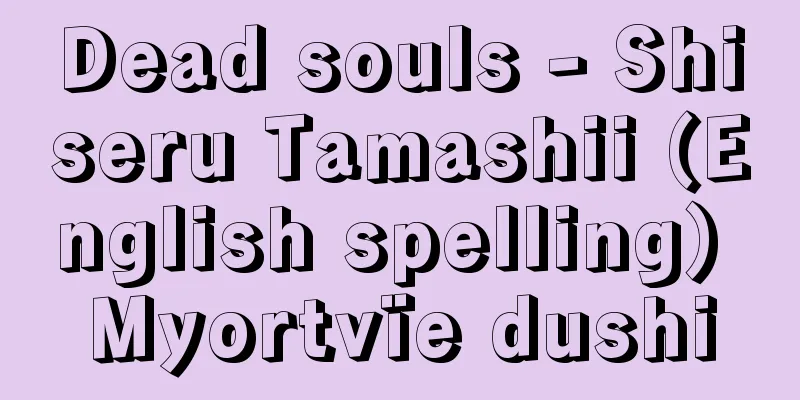Dead souls - Shiseru Tamashii (English spelling) Myortvïe dushi

|
A full-length novel by the Russian writer Gogol. It is the author's masterpiece and one of the masterpieces of 19th century Russian novels. It was planned to be a trilogy, but only the first part (published in 1842) remains in its complete form. It is a kind of picaresque novel, and the main theme of the whole story is the travels of a speculator named Chichikov, who visits various landlords with the aim of buying up dead serfs (called "souls" at the time) at low prices, registering them as living people, and using them as collateral to borrow money from the state treasury and fleeing to a foreign country. This simple plot is merely a framework for creating typical characters, and the immortal value of this novel lies in the grotesque yet extremely realistic character portrayals of the protagonist and various types of landlords and local bureaucrats. Through these images, the author tried to thoroughly expose the ills of Russian society at that time, while at the same time depicting the vulgarity that inevitably accompanies life itself. After publishing the first part, the author began writing the second part, which was supposed to depict the protagonist's repentance and rehabilitation. However, he was hindered by a sense of mission to become Russia's "spiritual" leader, a feeling that was already apparent at the end of the first part, and he destroyed the manuscript twice (1845, 1852), leaving only an incomplete fragment of an unfinished manuscript (published posthumously in 1853). [Shoichi Kimura] "Dead Souls" translated by Hajime Hirai and Mizuho Yokota (Iwanami Bunko)" ▽ "Dead Souls" translated by Shoichi Kimura (included in "World Literature 11" 1965 Chuokoron-Shinsha)" Source: Shogakukan Encyclopedia Nipponica About Encyclopedia Nipponica Information | Legend |
|
ロシアの作家ゴーゴリの長編小説。作者の代表作であり、19世紀ロシア小説の傑作の一つでもある。三部作になる予定であったが、完全な形で残っているのは第1部(1842刊)のみ。一種のピカレスク小説で、死んだ農奴(当時「魂」とよばれていた)を安値で買い集め、生きた者として登記し、これを抵当に国庫から金を借りて外国へ高飛びしようという目的で、ほうぼうの地主を歴訪するチチコフという山師の遍歴が全編の骨子になっている。この簡単な筋は、典型的な性格を造型するためのいわば枠組みにすぎず、この小説の不滅の価値は、主人公をはじめとするさまざまなタイプの地主や地方官僚たちのグロテスクでしかもきわめてリアルな人物形象のみごとさにある。これらの形象を通じて作者は、当時のロシア社会の病弊を余すところなく摘発すると同時に、人生そのものに必然的に付きまとう卑俗さを描き出そうとしたのである。 作者は第1部刊後、主人公の悔悟と更生を描くはずの第2部の執筆にとりかかったが、第1部の末尾にもすでにその徴候のほのみえる、ロシアの「霊的」指導者たらんとする一種の使命観に災いされて成功せず、二度にわたり草稿を破棄(1845、52)したため、不完全な未定稿の断片(1853死後刊)が残るのみである。 [木村彰一] 『平井肇・横田瑞穂訳『死せる魂』(岩波文庫)』▽『木村彰一訳「死せる魂」(『世界の文学11』所収・1965・中央公論社)』 出典 小学館 日本大百科全書(ニッポニカ)日本大百科全書(ニッポニカ)について 情報 | 凡例 |
<<: Sichuan [Province] - Sichuan
>>: Giselle - Jiselle (English spelling)
Recommend
Kazuo Asukata
Politician. Born in Yokohama. Graduated from Meij...
Illiberis rotundata (English spelling) Illiberisrotundata
…The bamboo grass moth Balataea funeralis is not ...
samsinhalmŏni (English spelling) samsinhalmoni
…In addition to the Uchigami, who are worshipped ...
Eusebius Sophronius Hieronymus
Latin Church Father, Bible scholar, and saint. Hi...
Josaphat
...It is derived from a Greek version (compiled b...
Lorenz, LV (English spelling) LorenzLV
...If the refractive index of a gas is n , its de...
Askiya Muhammad (English spelling)
…Son-i-Ali expanded his military conquests and be...
Di Manes (English spelling)
…In ancient Roman religion, the deified spirits o...
Lumped constant circuit - Lumped constant circuit
An electrical circuit that has a spatial scale sho...
Agnes Smedley
American journalist. Born into a poor farming fam...
Speed of sound
The speed at which sound waves travel through a m...
local variety
…Wheat is a crop that has been introduced to Japa...
Child Raising - Tonyanshi
A marriage system in old China where young girls b...
Asian Pharmacopoeia - Ajia Yakkyokuho
…In addition, the Nordic Pharmacopoeia was establ...
Mesoenatidae
…Any of the birds in the Mesoenatidae family, or ...









